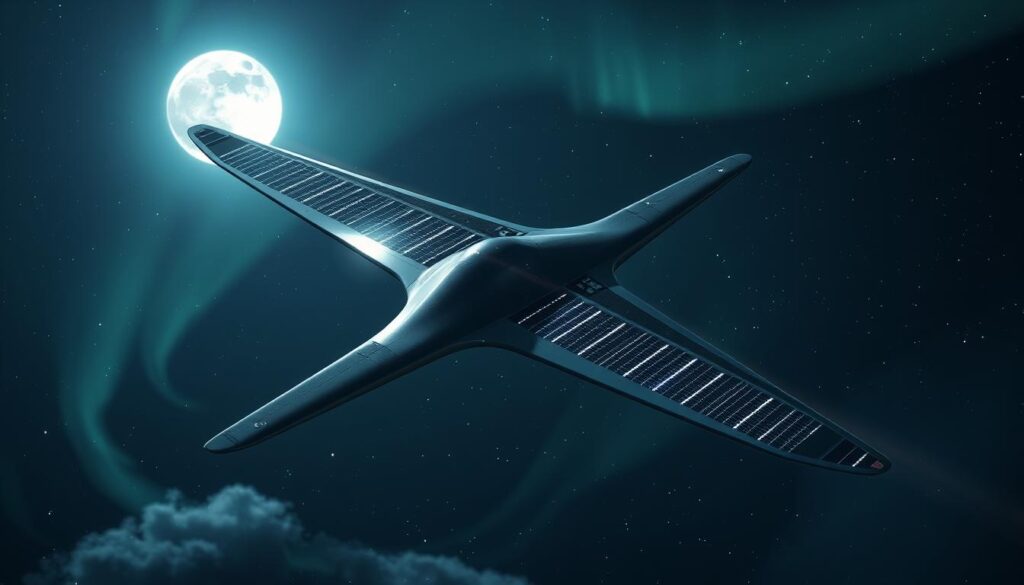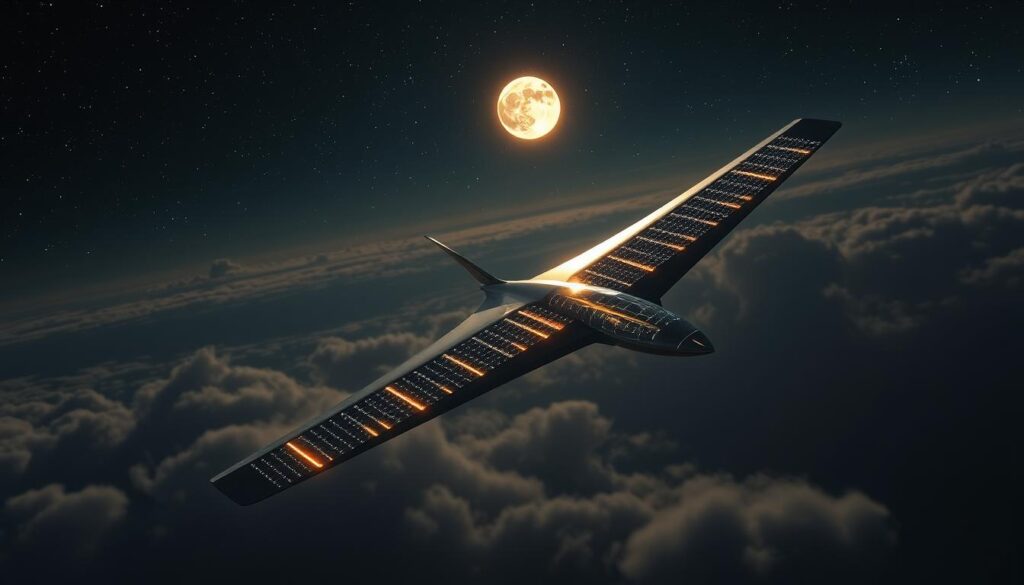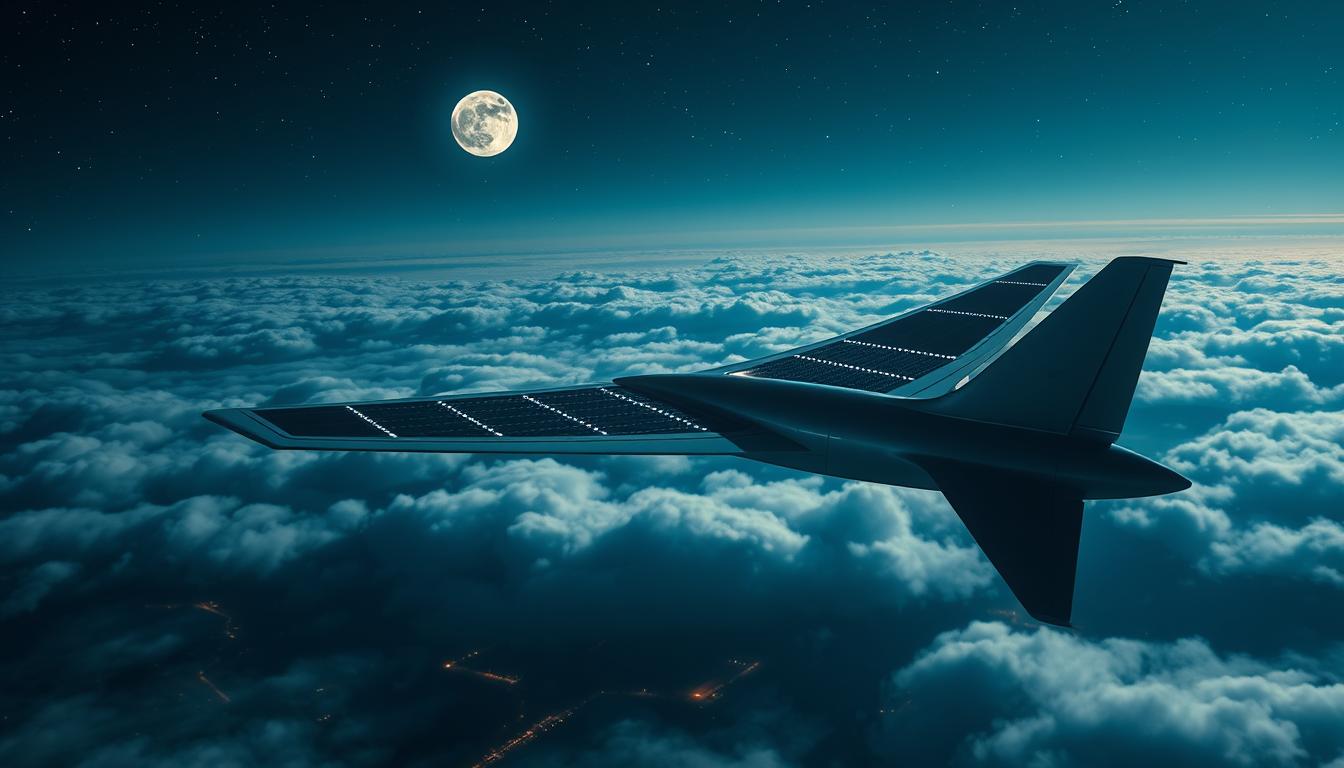Have you ever thought about how a solar plane can fly at night? The Solar Impulse aircraft has done the impossible. It uses solar energy even when the sun is down.
Learning about Solar Impulse shows us the future of flying with solar power. This plane proves that solar cells can power flight. It also opens doors to more energy-saving flights.
Key Takeaways
- The Solar Impulse aircraft has revolutionized solar flight at night, proving the efficiency of solar-powered planes.
- By using advanced energy storage solutions, Solar Impulse stores energy during daylight to ensure continued flight after sunset.
- The innovative design of Solar Impulse integrates lightweight materials and optimized aerodynamics to maximize performance.
- Solar Impulse’s technology highlights significant advancements in renewable aviation technology and sustainable energy use.
- Exploring Solar Impulse’s achievements provides insights into future possibilities and limitations of solar-powered aviation.
Introduction to Solar Impulse
Solar Impulse is a groundbreaking project that combines innovation and sustainability. It uses clean technologies to show the power of renewable energy. This solar aircraft challenges old ways in aviation.
At its core, Solar Impulse has a big vision. It also has the help of key people who made this dream come true.
The Vision Behind Solar Impulse
Swiss entrepreneurs started Solar Impulse with a bold dream. They wanted to fly day and night using only solar power. This project aims to break new records and prove renewable energy works in aviation.
By using clean technologies, Solar Impulse wants to inspire a sustainable future for flying.
Key Figures and Milestones
Dr. Bertrand Piccard, a psychiatrist and explorer, and engineer André Borschberg are key to Solar Impulse’s success. Their hard work and knowledge helped the project reach amazing goals.
They set records with high-altitude flights and flew around the world from 2015 to 2016. Solar Impulse’s journey started in Abu Dhabi and went across many continents. It showed the world what solar aircraft can do.
| Year | Milestone | Significance |
|---|---|---|
| 2010 | First Night Flight | Illustrated the feasibility of solar-powered aviation during night hours. |
| 2015-2016 | Around-the-World Journey | Completed in multiple legs, proving the endurance and reliability of solar aircraft. |
The Solar-Powered Aircraft: Design and Technology

The Solar Impulse is a major step in green flying, using smart design and materials for amazing solar flights. We’ll look at three main parts: its aerodynamic design, solar cell setup, and use of light materials.
Innovative Aerodynamic Design
The Solar Impulse’s design is truly groundbreaking. It focuses on being precise and efficient, cutting down on drag. This lets it fly smoothly and efficiently.
Its long body and wide wings are carefully made. They help lift the plane up and cut down on air resistance. This makes flying with the sun’s power possible.
Solar Cell Integration
The plane’s surface is covered in solar cells, a key part of its design. These cells soak up sunlight all day. They power the plane’s systems and help it move.
This shows how solar tech can change flying. It’s a big step forward in using the sun’s power for flight.
Use of Lightweight Materials
Light materials, like carbon fiber, are key to the plane’s success. They’re strong but light, which helps the plane stay up in the air. This makes flying longer and more efficient.
| Key Component | Material | Benefits |
|---|---|---|
| Fuselage | Carbon Fiber | High Strength, Reduced Weight |
| Wings | Lightweight Composites | Efficient Lift, Lower Drag |
| Solar Cells | Silicon | High-Efficiency Power Generation |
The Challenges of Solar Flight
The journey to make solar-powered planes is filled with challenges. These include finding ways to store energy for flight and managing long trips. To overcome these, new ideas and plans have been developed. They help make high-altitude solar flight a reality.
Energy Storage Solutions
Storing energy for solar planes is a big problem. Solar Impulse has found a solution with high-density lithium polymer batteries. These batteries hold enough power to fly at night.
Creating strong energy storage is key. It lets planes fly for a long time without losing power.
Flight Strategies and Altitude Management
Managing altitude is crucial for solar flights. Flying high during the day and low at night helps save energy. This plan lets planes use the sun’s power better and use less energy.
| Challenge | Solution | Impact |
|---|---|---|
| Energy Storage for Solar Flight | High-density lithium polymer batteries | Ensures energy availability during night flights |
| High-Altitude Solar Flight | Altitude management strategies | Optimizes energy use and efficiency |
If Solar Impulse is Powered by the Sun, How Does It Fly at Night?

When we talk about Solar Impulse flying at night, we must look at two key things. These are the role of battery storage and effective energy management during the flight.
The Role of Battery Storage
Solar Impulse has advanced battery storage. This is key for flying at night. During the day, it uses solar cells to make electricity. This electricity is stored in batteries to power it at night.
The batteries are made to keep the plane flying at night. This shows how solar power can be used all day and night for flying.
Energy Management During Day and Night
Managing energy well is crucial for Solar Impulse’s night flights. The pilots have to balance collecting, storing, and using energy. During the day, they store extra energy for later.
At night, they use the stored energy wisely. They keep an eye on how much energy they use. This way, they can keep flying until the sun comes up again.
| Aspect | Daytime Operations | Nighttime Operations |
|---|---|---|
| Energy Source | Solar Power | Battery Storage Technology |
| Energy Collection | High | None |
| Energy Consumption | Moderate | High |
Historic Flights and Records
The Solar Impulse project made history with its groundbreaking solar aviation achievements, setting multiple aerial records.
First Night Flight in 2010
On July 7, 2010, pilot Markus Scherdel made history with the first night flight. He flew for 26 hours, 10 minutes, and 19 seconds. This showed that solar power works even when it’s dark.
This flight was a big step for Solar Impulse. It proved the plane’s ability to store and use energy well.
Around the World in 2015-2016
The Solar Impulse 2 flew around the world from 2015 to 2016. It aimed to show the world the power of clean energy. The plane broke many records during this trip.
This journey took the plane to many continents. It showed that flying with solar power is possible.
Piloting the Solar Impulse
Piloting solar aircraft like the Solar Impulse is a unique challenge. It demands great endurance and vigilance from pilots. The pilots face the task of managing oxygen in an unheated cockpit over long periods.
Challenges Inside the Cockpit
The Solar Impulse’s cockpit is light and efficient. However, it poses specific challenges. Pilots have to deal with cramped space, temperature changes, and keeping oxygen levels right.
Since it’s not pressurized, pilots must use personal oxygen systems. This adds complexity to their missions.
Endurance and Vigilance
Endurance is key when flying solar aircraft like the Solar Impulse. André Borschberg and Bertrand Piccard showed incredible endurance on their long flights. Their concentration and stamina were crucial.
Even small mistakes could risk the entire mission. Their vigilance was essential.
The Impact on Aviation Technology
The Solar Impulse project has made huge strides in aviation. It shows how renewable energy can power long flights. The solar propulsion technology used by Solar Impulse is a game-changer.
It combines renewable energy with advanced propulsion systems. This sets a high standard for future aircraft design and energy use.
Advancements in Renewable Energy
The Solar Impulse project has a big impact on renewable energy. It uses solar cells to power the aircraft’s electric motors. This is a big step forward in aviation technology.
It reduces our need for fossil fuels and shows the way to cleaner flying. Solar Impulse is leading the way for more renewable energy in aviation.
Innovation in Propulsion Systems
The Solar Impulse project has brought big changes in how planes move. It uses electric motors powered by the sun. This is a big change from using traditional fuels.
This shows that solar power can work well for planes. It’s a sign of things to come in aviation, with a focus on being green and using less energy.
| Feature | Traditional Aircraft | Solar Impulse |
|---|---|---|
| Energy Source | Fossil Fuels | Solar Energy |
| Propulsion | Combustion Engines | Electric Motors |
| Environmental Impact | High Emissions | Zero Emissions |
| Flight Duration | Limited by Fuel | Potentially Unlimited |
Environmental Benefits of Solar-Powered Flight
The rise of solar-powered aviation is a big step towards making air travel greener. It uses solar energy, which means no emissions during flight.
The Solar Impulse project shows how flights can be green by using renewable energy. This new way of flying aims to cut down on the usual pollution from planes. It’s a big step towards a more eco-friendly aviation industry.
Using solar power in planes helps reduce global emissions. Solar Impulse’s work is inspiring others to follow their lead. This could lead to big changes in how we travel.
To understand the benefits of solar-powered flight, let’s compare it to traditional planes:
| Aspect | Traditional Aircraft | Solar-Powered Aircraft |
|---|---|---|
| Emissions | High | None |
| Fuel Dependency | Fossil Fuels | Solar Energy |
| Carbon Footprint | Large | Minimal |
Switching to solar power in planes is a key move towards greener skies. It shows us a future where flying is cleaner and more sustainable. This change could make a big difference for our planet.
The Future of Solar Aviation
The future of flying is changing with solar power. New technology and designs are making solar planes a reality. They will change how we travel by air in a green way.
Next-Generation Solar Aircraft
Next-generation solar planes are on the horizon. They will be more efficient, with better batteries and solar panels. This means longer flights and more reliable travel.
Possibilities and Limitations
But, there are still challenges with solar planes. Today’s solar cells and batteries have their limits. We need more research to make solar flying work better.
Knowing what’s possible and what’s not helps us plan for the future. We must be both hopeful and realistic. This way, we can make flying greener while facing the challenges ahead.
| Aspect | Current State | Future Potential |
|---|---|---|
| Solar Cell Efficiency | Moderate | High |
| Energy Storage | Limited | Enhanced |
| Flight Duration | Short to Moderate | Extended |
| Reliability | Variable | Improved |
Conclusion
Solar Impulse’s journey goes beyond just flying high and setting records. It shows the amazing potential of renewable energy in flying. With advanced design and solar power, Solar Impulse proves flying can be green.
This project has made the world think differently about energy and the environment. It has changed how we see energy use in flying. Solar Impulse has also led to big steps forward in renewable energy, affecting more than just flying.
The future of Solar Impulse looks bright. It has inspired new solar planes and green flying ideas. By following this path, we can make flying cleaner and greener for everyone.
FAQ
If Solar Impulse is powered by the sun, how does it fly at night?
What is the vision behind Solar Impulse?
Who are the key figures behind the Solar Impulse project?
What are some milestones achieved by Solar Impulse?
What makes Solar Impulse’s design unique?
How are solar cells utilized in the Solar Impulse?
How does Solar Impulse manage energy storage for night flights?
What flight strategies are implemented for energy conservation?
What was the significance of the first night flight in 2010?
Describe the around-the-world flight of Solar Impulse in 2015-2016.
What challenges do pilots face in the Solar Impulse cockpit?
How has Solar Impulse impacted aviation technology?
What are the environmental benefits of solar-powered flight?
What does the future hold for solar aviation?
Source Links
- Solar Impulse – https://airandspace.si.edu/stories/editorial/solar-impulse
- Solar Impulse – Around the world to promote clean technologies – https://aroundtheworld.solarimpulse.com/adventure/technical-challenge-1
- Solar-Powered Plane Uses Its Lightness To Fly In The Dark – https://www.npr.org/sections/alltechconsidered/2013/03/27/175371800/solar-powered-plane-uses-its-lightness-to-fly-in-the-dark




Interesting read, but wouldnt solar-powered flight be severely limited in regions with less sunlight? Its not always sunny everywhere, right?
So, if Solar Impulse can fly at night, why arent all planes solar-powered? Whats holding back this tech revolution?
Interesting read, but isnt the Solar Impulse more of a publicity stunt than a realistic solution for commercial air travel? Thoughts?
Interesting article, but isnt the whole night flying concept a paradox? How can a solar-powered plane function without the sun? Just food for thought.
Isnt it fascinating how Solar Impulse is challenging the status quo of aviation? Sustainable travel really could be closer than we think!
Interesting read! But isnt storing solar energy for night flights still a huge challenge? Whats the efficiency of these storage systems?
Interesting read! But, isnt storing solar energy for night flights still a major hurdle to Solar Impulses wider implementation?